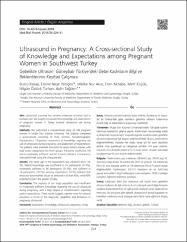| dc.contributor.author | Kasap, Burcu | |
| dc.contributor.author | Yeniçeri, Emine Neşe | |
| dc.contributor.author | Akın, Melike Nur | |
| dc.contributor.author | Akbaba, Eren | |
| dc.contributor.author | Küçük, Mert | |
| dc.contributor.author | Turhan, Nilgün Öztürk | |
| dc.contributor.author | Sağlam, Aylin | |
| dc.date.accessioned | 2020-11-20T14:55:39Z | |
| dc.date.available | 2020-11-20T14:55:39Z | |
| dc.date.issued | 2016 | |
| dc.identifier.issn | 1302-0072 | |
| dc.identifier.issn | 2147-2688 | |
| dc.identifier.uri | https://doi.org/10.4274/haseki.3234 | |
| dc.identifier.uri | https://hdl.handle.net/20.500.12809/2259 | |
| dc.description | WOS: 000391200000006 | en_US |
| dc.description.abstract | Aim: Ultrasound scanning has become universally accepted tool in prenatal care. We sought to evaluate the knowledge and expectations of pregnant women in Turkey towards ultrasound use during pregnancy. Methods: We performed a cross-sectional study of 108 pregnant women in Mugla Sitki Kocman University. The subjects completed a questionnaire consisting of three sections: Sociodemographic characteristics, 13-question assessment of knowledge regarding the use of ultrasound during pregnancy, and assessment of expectations. The patients were awarded one point for every correct answer, with total scores categorized into three groups: 0-4 points insufficient, 5-8 points moderately sufficient, and 9-13 points sufficient. Comparisons were performed using the chi-square test. Results: The mean age of the respondents was 28.6 +/- 4.9 years (18-39). Patient knowledge was insufficient in 34 participants (31.4%), moderately sufficient in 56 participants (51.9%), and sufficient in 18 participants (16.7%). Among respondents, 31.5% believed that structural abnormalities would be detected in at least 40%, while 99% expected to learn the gender of baby. Conclusion: The majority of our study population had insufficient to moderately sufficient knowledge regarding the use of ultrasound during pregnancy, with a high degree of misinformation regarding patient expectations. These results suggest a greater need for national education in terms of the diagnostic capabilities and limitations of pregnancy ultrasound. | en_US |
| dc.item-language.iso | tur | en_US |
| dc.publisher | Galenos Yayincilik | en_US |
| dc.item-rights | info:eu-repo/semantics/openAccess | en_US |
| dc.subject | Expectation | en_US |
| dc.subject | Knowledge | en_US |
| dc.subject | Ultrasound | en_US |
| dc.subject | Pregnancy | en_US |
| dc.subject | Turkey | en_US |
| dc.title | Ultrasound in Pregnancy: A Cross-sectional Study of Knowledge and Expectations among Pregnant Women in Southwest Turkey | en_US |
| dc.item-type | article | en_US |
| dc.contributor.department | MÜ, Tıp Fakültesi, Cerrahi Tıp Bilimlieri Bölümü | en_US |
| dc.contributor.institutionauthor | Kasap, Burcu | |
| dc.contributor.institutionauthor | Yeniçeri, Emine Neşe | |
| dc.identifier.doi | 10.4274/haseki.3234 | |
| dc.identifier.volume | 54 | en_US |
| dc.identifier.issue | 4 | en_US |
| dc.identifier.startpage | 224 | en_US |
| dc.identifier.endpage | 231 | en_US |
| dc.relation.journal | Haseki Tip Bulteni-Medical Bulletin of Haseki | en_US |
| dc.relation.publicationcategory | Makale - Uluslararası Hakemli Dergi - Kurum Öğretim Elemanı | en_US |


















